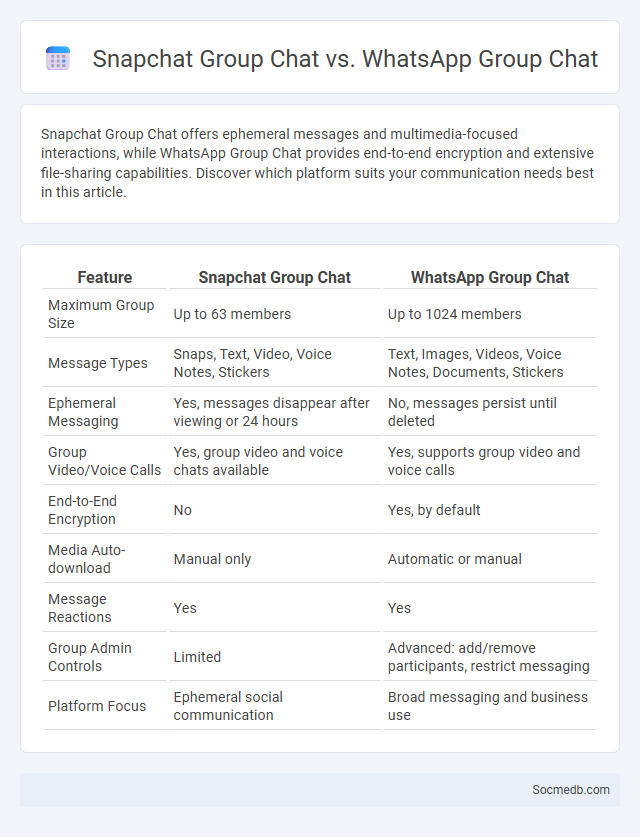
Photo illustration: Snapchat Group Chat vs WhatsApp Group Chat
Snapchat Group Chat offers ephemeral messages and multimedia-focused interactions, while WhatsApp Group Chat provides end-to-end encryption and extensive file-sharing capabilities. Discover which platform suits your communication needs best in this article.
Table of Comparison
| Feature | Snapchat Group Chat | WhatsApp Group Chat |
|---|---|---|
| Maximum Group Size | Up to 63 members | Up to 1024 members |
| Message Types | Snaps, Text, Video, Voice Notes, Stickers | Text, Images, Videos, Voice Notes, Documents, Stickers |
| Ephemeral Messaging | Yes, messages disappear after viewing or 24 hours | No, messages persist until deleted |
| Group Video/Voice Calls | Yes, group video and voice chats available | Yes, supports group video and voice calls |
| End-to-End Encryption | No | Yes, by default |
| Media Auto-download | Manual only | Automatic or manual |
| Message Reactions | Yes | Yes |
| Group Admin Controls | Limited | Advanced: add/remove participants, restrict messaging |
| Platform Focus | Ephemeral social communication | Broad messaging and business use |
Introduction to Group Chat Platforms
Group chat platforms revolutionize communication by enabling real-time, multi-user conversations that foster collaboration and social interaction. These platforms support various features like file sharing, video calls, and customizable notifications to enhance user experience. Your ability to connect instantly with colleagues, friends, or communities through group chat platforms streamlines communication and boosts productivity.
Popularity and User Demographics
Social media platforms like Facebook, Instagram, TikTok, and Twitter boast billions of active users globally, with TikTok rapidly gaining popularity among Generation Z. User demographics vary significantly: Facebook's largest age group ranges from 25 to 34 years, while Instagram attracts a younger audience between 18 and 29 years. Gender distribution is balanced on most platforms, but LinkedIn tends to have a higher percentage of male professionals.
Group Creation and Member Limits
Creating groups on social media platforms enables users to build communities centered around shared interests, with member limits varying between platforms to optimize engagement and manageability. For instance, Facebook groups can hold up to 1 million members, while WhatsApp limits group sizes to 1024 participants, ensuring your group remains focused and manageable. Understanding these member limits helps you effectively plan your community's growth and interaction dynamics.
Privacy and Security Features
Social media platforms implement advanced privacy and security features such as end-to-end encryption, two-factor authentication, and customizable privacy settings to protect user data and control content visibility. Robust measures like AI-driven threat detection systems and regular security audits help prevent unauthorized access, data breaches, and cyberattacks. Users can manage permissions for apps and third-party integrations, ensuring greater control over personal information shared on platforms like Facebook, Instagram, and Twitter.
Message Management and Controls
Message management and controls on social media platforms enable users to filter, prioritize, and organize communications for enhanced engagement and security. Features such as message filtering, keyword blocking, and customized notification settings help prevent spam and unwanted interactions, fostering a safer online environment. Advanced control options empower users to manage message visibility and interaction permissions, ensuring effective communication and privacy.
Multimedia Sharing Capabilities
Social media platforms offer robust multimedia sharing capabilities, allowing users to upload, edit, and distribute images, videos, and audio seamlessly. Platforms like Instagram, TikTok, and YouTube prioritize high-resolution content and interactive features such as live streaming, stories, and reels to enhance user engagement. Your ability to share diverse multimedia content boosts visibility and fosters dynamic online interactions.
Customization and Personalization Options
Social media platforms offer extensive customization and personalization options that enhance your online experience by tailoring content feeds, notifications, and privacy settings to your preferences. Advanced algorithms analyze your interactions and behaviors to provide relevant advertisements, friend suggestions, and content recommendations, ensuring that your social media environment remains engaging and relevant. These features empower you to control how your data is used and how your digital presence is displayed, maximizing both usability and security.
Notifications and Muting Features
Social media platforms offer advanced notifications settings that allow you to customize alerts for messages, comments, and likes, ensuring you stay informed about important interactions without being overwhelmed. Muting features enable you to silence specific conversations or users temporarily, helping you maintain focus and reduce distractions while still remaining connected. These tools empower you to create a balanced and manageable social media experience tailored to your priorities.
Integrations and Third-Party Support
Social media platforms offer extensive integrations and third-party support, enabling seamless connections with analytics tools, marketing software, and customer relationship management (CRM) systems. APIs and plugins facilitate automation, data synchronization, and enhanced user engagement across multiple channels. These integrations empower businesses to optimize campaigns, track performance metrics, and deliver personalized content efficiently.
Pros, Cons, and Final Comparison
Social media platforms offer significant benefits such as enhanced communication, real-time information sharing, and opportunities for business growth through targeted marketing. However, they also pose risks including privacy concerns, cyberbullying, and misinformation proliferation, which can negatively impact mental health and societal trust. Balancing these advantages and disadvantages depends on user behavior, platform regulations, and the ability to leverage social media responsibly for personal and professional use.
 socmedb.com
socmedb.com